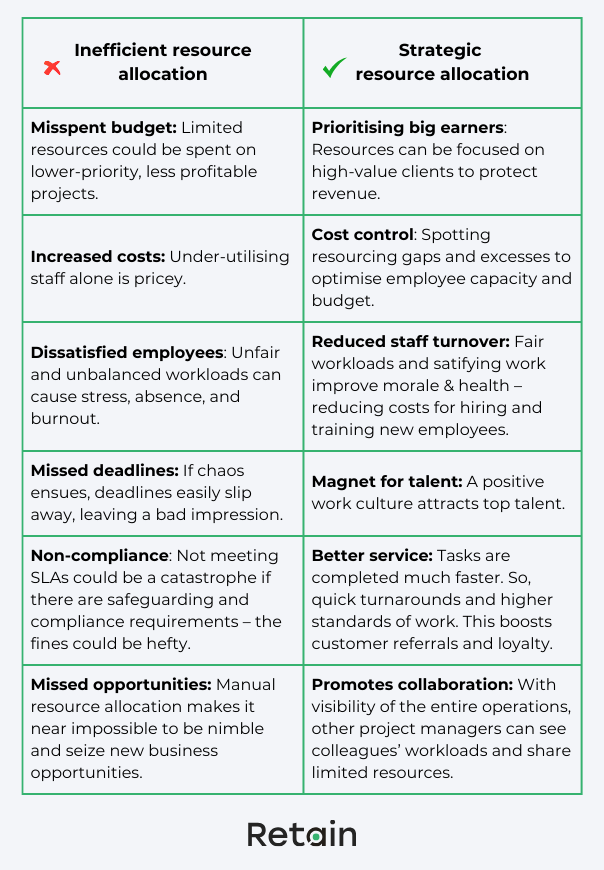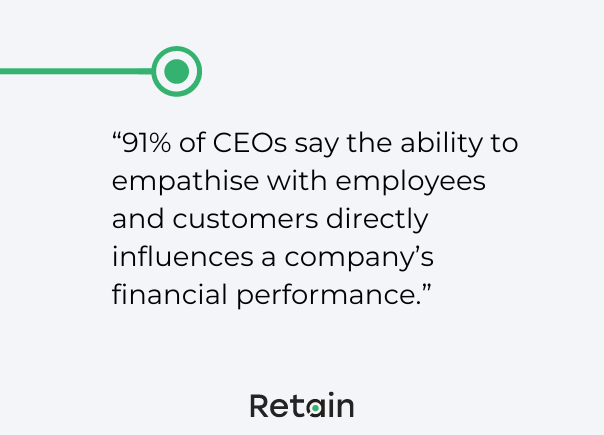Getting resource allocation right is about more than just efficient use of time and budgets. It’s about aligning the right resources to the right work at the right time. It takes finesse.
You want to meet client demand efficiently or risk missing deadlines. But, you also want your most precious asset—your talented team members—to work together and not feel overwhelmed or under-utilised.
The profitability of the company literally relies on balancing this just right. No pressure.
Let’s unpick resource allocation. Starting with a quick definition of what is resource allocation, we’ll then dive into best practices to balance operational efficiency with employee wellbeing.
What is resource allocation?
Resource allocation is when limited resources like employee capacity, time and budget are strategically mapped out for each client to meet demand – whilst also generating profit.
Often, it involves making decisions about:
- How to map the right skills to each job
- How to prevent over- and under-utilisation of specialists
- How to balance workloads fairly across the business
This isn’t a one-off exercise. As client demands change, workloads spike or dip, or there’s staff turnover, resource allocation needs reviewing regularly.
That means balancing:
- Budgets
- Time and timescales for other projects
- Skills required
- Specialist employees’ time
- Any kit needed (laptops, licences etc)
After all, managing these resources in the most efficient way delivers great service, drives productivity, controls costs, and boosts employee satisfaction.
Let’s go into this a little more.
Why resource allocation matters
Now we’ve covered what is resource allocation, we’ll look at the impact of poor versus best practice resource planning.

There are so many benefits. But, this all might sound quite theoretical so here are some stats to back it up:
- 11.4% of all resources are wasted due to poor management.
- Poor resource allocation leads to a failure rate increase by a factor of ⅔.
- 91% of CEOs say the ability to empathise with employees and customers directly influences a company’s financial performance.
To sum it up: Careful resource allocation allows businesses to meet targets without exceeding budgets or overworking employees. It provides managers with a birds-eye view of gaps and needs to stop limited resources being wasted on tasks that are low priority and instead focus resources where it will make the biggest impact.
And it creates a happy workplace where people are motivated to go above and beyond.

7 best practices for effective resource allocation
Streamlining resource allocation takes more than just juggling schedules – it requires informed planning and decisions. Here are proven strategies used by leading service businesses:
#1: Spotlight top priorities
Find your highest value clients and the ones with the most pressing needs to then focus on the critical projects. Knowing this means you can deploy the A-team resources.
The benefits? Businesses that spotlight tasks by urgency and value report higher client satisfaction. It’s a more efficient way to maximise resources and protect or even generate greater revenue.
#2: Let data lead the way
Using tools that provide real-time resource availability – an instant view of how the resource is being used right now – allows you to make quick, accurate decisions. It’s something that just can’t be done manually through spreadsheets.
The benefits? Businesses that leverage data-driven and real-time insights see higher project completion rates and fewer missed deadlines.
#3: Stay nimble
Building in flexibility is a must-have for resource allocation if you want to keep on track – and seize opportunities for growth. This means building in contingencies to adjust work schedules as priorities or scope shifts.
The benefits? It’s a sure-fire way to boost efficiency and better protect the business against reputational damage and compliance breaches.
#4: Share talent
If you share specialist teams across the business, this one's for you. Through a clear plan and understanding of resource allocation, departments can see when resources are needed and when it’s free.
The benefits? This makes for better collaboration. Increases the ROI of specialists’ costs. Inspires innovation and shares learning. And so much more.
#5: Fine tune as you go
Resource allocation should be an ongoing process with regular reviews to switch plans up based on performance metrics and changing needs. Don’t wait for results to dip before doing this – it’s why real-time data is so important.
The benefits? Quarterly reviews alone boost operational efficiency and support revenue growth.
#6: Sharpen skills
Continually investing in personal development for resources allows you to increase skill sets and more easily match employees to jobs – because simply more people will have the skills you need. If you keep a close ear to the ground, and leverage real-time data, you may spot these needs before that first enquiry lands.
The benefits? As client demand inevitably changes, this allows you to fulfil new business needs and retain clients.
#7: Automate
This is quite a tall list and would be nearly impossible to manage without the right tech. There are so many resource management tools – some way more advanced than others, giving businesses a huge competitive advantage… Like these AI-powered software tools.
The benefits? The question is where do we start? It saves money, reduces project management stress, and provides a central platform for resource information so that everyone can access it in one place. Keen to learn more? The next section is for you ?
Why leading service businesses use resource allocation technology
Leveraging one single platform – bespoke built for resource management – has a multitude of benefits.
Here are just a handful:
🟢Real-time visibility: See when staff are available, their skill sets, and how high or low their workloads are.
🟢Predictive forecasting: Forecast upcoming resourcing needs based on historical data.
🟢Analytics and reporting: Highlights areas of improvement using past and current resource utilisation data.
🟢Communication features: Boost collaboration across departments with greater visibility and make joint decisions about resource allocation so everyone is aligned to meet business goals.
You can see how this one solution helps balance optimised resource utilisation, without overburdening staff. It means maximum efficiency and productivity.
Optimise productivity and morale with strategic resource allocation
Balancing financial needs with employee well-being and satisfaction takes effort – unless you take advantage of tech and this all changes. Keeping a close eye on how limited resources are shared helps to eliminate bottlenecks, over and under-utilising staff, missing deadlines, or going over budget – and so much more.
And the benefits of managing it right are endless. For example, not only do employees feel empowered to do their best work, you can attract and retain top talent and protect profit margins.
Key takeaway: Thought resource allocation creates a happy, healthy workplace, smooth operations, and healthier profit margins.
Your next steps
Make balancing everything simple with Retain's resource management software.
Looking for more? Read more about resource management here:


